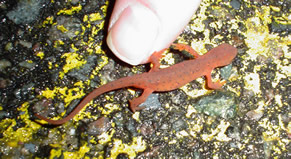Salamander Story
March 2008
 The combination of melting snow, rising temperatures, and rain one weekend last March triggered the annual migration of salamanders to their breeding grounds. Our relatives from New York City were visiting for the weekend, so we took a ride over toMoose Hill Audubon Wildlife Sanctuary in Sharon on Saturday night to witness the event.
The combination of melting snow, rising temperatures, and rain one weekend last March triggered the annual migration of salamanders to their breeding grounds. Our relatives from New York City were visiting for the weekend, so we took a ride over toMoose Hill Audubon Wildlife Sanctuary in Sharon on Saturday night to witness the event.
Arriving at Moose Hill, we encountered barricades manned by volunteers, who told us the road was temporarily blocked to traffic to spare the migrating amphibians from getting squashed by car tires. We parked, grabbed our umbrellas and flashlights, and headed down the road. As we walked, we scanned the pavement for signs of life but at first saw nothing. Then we saw flashlights ahead. Several people were crowded around the pool of light on the road, in the center of which sat a wood frog. They told us that there were also many tiny tree frogs, called spring peepers, hopping around and advised us to walk slowly and try not to step on them. Sweeping their flashlights around, they quickly located a tiny tree frog about the size of my fingernail, and then a couple more. They also told us that the odd quacking sounds emanating from the woods were the mating calls of wood frogs, whereas the cricket-like chirping sounds were the tree frogs’ calls.
 Moving carefully on, we rounded a curve in the road and encountered a fat black mole salamander with bright yellow spots. It was purposefully crossing the road from its underground home in the woods to the vernal pool where it was born and where it joins hundreds of others every spring to spawn. Cold, clear vernal pools last a few months before drying up in summer, just long enough to allow the salamander tadpoles to emerge as air-breathing creatures but not long enough to support a fish population that would otherwise eat them. The vernal pools provide the tadpoles with a rich diet of fairy shrimp, mosquito larvae, and other tiny prey.
Moving carefully on, we rounded a curve in the road and encountered a fat black mole salamander with bright yellow spots. It was purposefully crossing the road from its underground home in the woods to the vernal pool where it was born and where it joins hundreds of others every spring to spawn. Cold, clear vernal pools last a few months before drying up in summer, just long enough to allow the salamander tadpoles to emerge as air-breathing creatures but not long enough to support a fish population that would otherwise eat them. The vernal pools provide the tadpoles with a rich diet of fairy shrimp, mosquito larvae, and other tiny prey.
We met another group of flashlight-toting walkers guided by Patty Shaver of the Moose Hill Sanctuary. Patty told us to tread carefully because there were numerous red efts crossing along with the yellow-spotted salamanders. It was not long before we found some of these earthworm-sized red salamanders trekking across the pavement toward the vernal pool.
Having seen four species of amphibians in less than an hour, we headed home. As we returned, the drizzle increased to light rain, and we encountered more salamanders crossing the road than we had on the way there. Experiencing the instinctive spawning migration of these secretive amphibians provided us with a memorable reminder of the miracle of nature that surrounds and sustains us. As vernal pools and
woodland habitat are increasingly compromised by development, acid rain, mercury, global warming, and other factors related to human activities, we can only wonder if our descendants will be similarly privileged.

